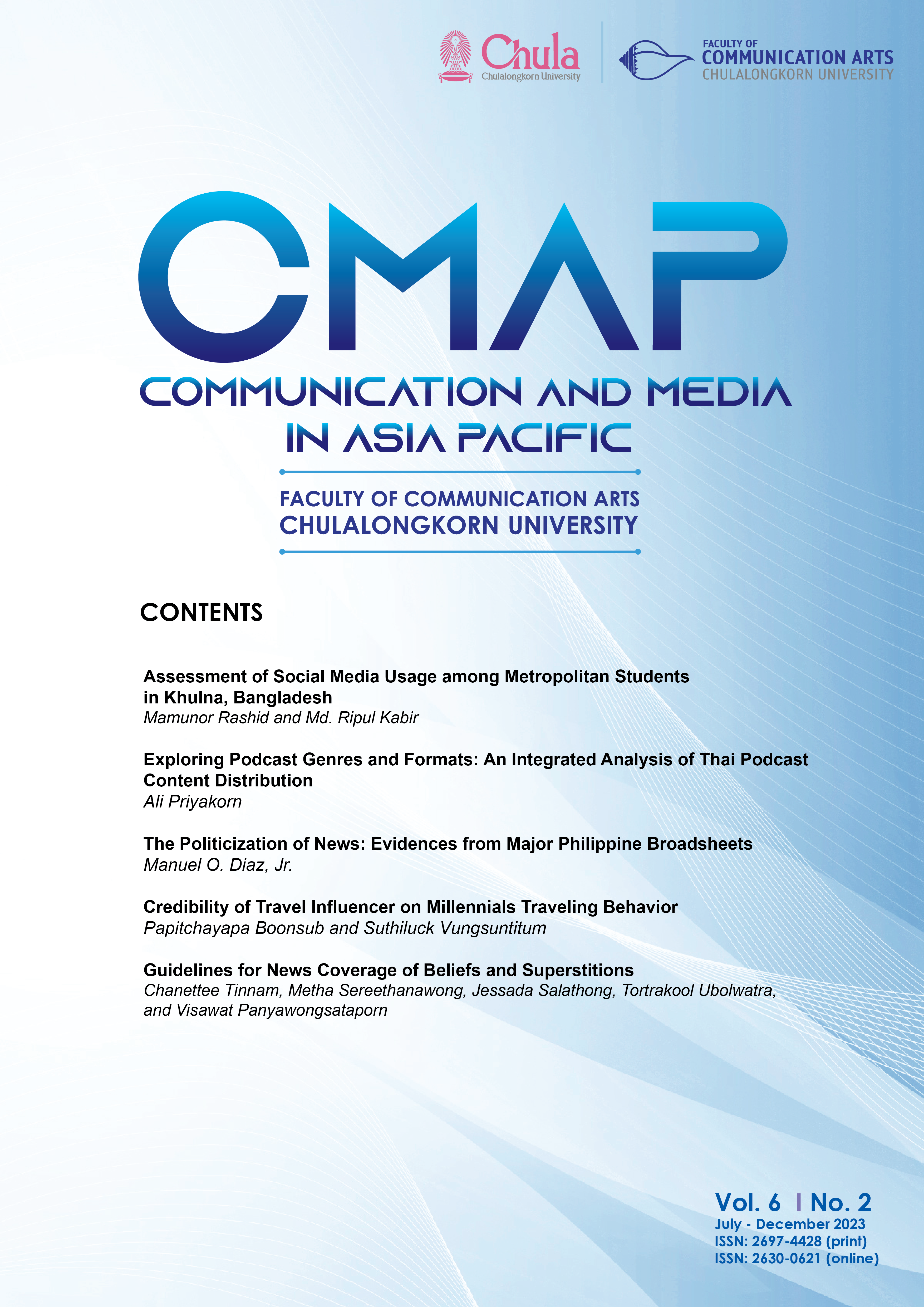Guidelines for News Coverage of Beliefs and Superstitions
Main Article Content
Abstract
As a multicultural society, Thailand embraces a variety of cultural beliefs. Furthermore, common practices of Thai people are characterized by beliefs and superstitions that confer their own distinctiveness; this is the other side of the coin that virtually reflects the act of violence. Thai society is afflicted with numerous detrimental effects caused by news coverage on superstitious beliefs. These include gambling, frauds, and exploitation of goods and services. The Thai media should offer a balance between presenting cultural diversity within the context of these beliefs and superstitions that still exist in society. Accordingly, as a watchdog, the content relating to beliefs and superstitions should be screened in order to eliminate the harmful effects on society. This study thus seeks to formulate comprehensive guidelines for mass media entities regarding the presentation of belief-relevant content. In accordance with methodologies, this involves a comprehensive analysis of relevant documents and television content, as well as focus group discussions. The findings of the study demonstrated that there are six aspects of media ethics that can be used to regulate programs of news reporting on digital television to be presented to the media regulation body of the National Broadcasting and Telecommunications Commission (NBTC) in Thailand. The six aspects are exhibited within the framework of the following principles: accuracy, objectivity, human rights, diversity, balance and fairness, and social responsibility.
Article Details
References
Ajarayutt, N. (2018). The role of newspapers in reproducing beliefs for luck seeking. Journal of Science, 14(1), 84-121.
Attakorn, K. (1977). Public attitude. Bangkok: Teacher Training Unit, Department of Teacher Training.
Baudrillard, J. (1994). Simulacra and simulation. Ann Harbor, MI: University of Michigan Press.
Duangwiset, N. (2017). Anthropological perspectives on the study of animistic beliefs in Thai society. Academic Journal of Humanities and Social Sciences, Burapha University, 25(47), 173-197.
Entman, R. M. (2002). Framing: Towards clarification of a fractured paradigm. In D. McQuail (Ed.). McQuail’s reader in mass communication theory. London: Sage.
iLaw Freedom. (2019). Learning from the content control of media by the power of NBTC with Supinya Klangnarong. https://freedom.ilaw.or.th/en/node/701
Kaewthep, K. (2009). Mass communication: Theory and research directions. Bangkok, Thailand: Chulalongkorn University.
Kaewthep, K., & Hinviman, S. (2017). The stream of political economy theorists and communication studies. Mahasarakham, Thailand: Inthani.
Lumchomkae, E. (2021). Interview in open house ThaiPBS. Know the media: When news mixes with superstition. https://program.thaipbs.or.th/watch/aurEbh
Media Alert. (2021). The superstitious beliefs in television news programs. In Research project on the situation of media and media reception behavior. Bangkok, Thailand: Policy and Strategy Division, Thai Media Fund.
National Press Council of Thailand. (2022). Guidelines of the National Press Council on News Presentation and news imagery concerning superstitious beliefs, numbers, and lottery gambling, B.E. 2565. https://www.presscouncil.or.th/regulation/7292
Oitekkeng, K. (2021). Ghosts, brahmas, buddha: The return of interest in 'superstition' among the new generation. https://www.matichonweekly.com/religion/article_460792
Siebert, F. S., Peterson, T., & Schramm, W. (1963). Four theories of the press: The authoritarian, libertarian, social responsibility, and soviet communist concepts of what the press should be and do. Urbana, IL: University of Illinois Press.
Ratchabandittayasathan. (2011). Royal institute dictionary. Bangkok, Thailand: Aksorn Charoen Tat Press.
Thitadhammo (Arayanarakul), P. M. (2021). Management of belief affecting the Buddhist mind: A case study of Wat Chedi. Journal of MCU Nakhondhat, 8(6), 61-76.
Workpoint Today. (2020). Thai ghost movies with terrifyingly high earnings. https://workpointtoday.com/8- thaighost _film-Kotsayongtumnguen/


